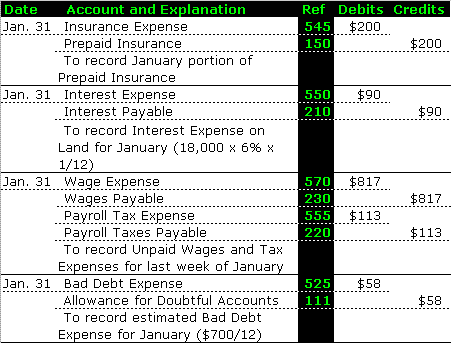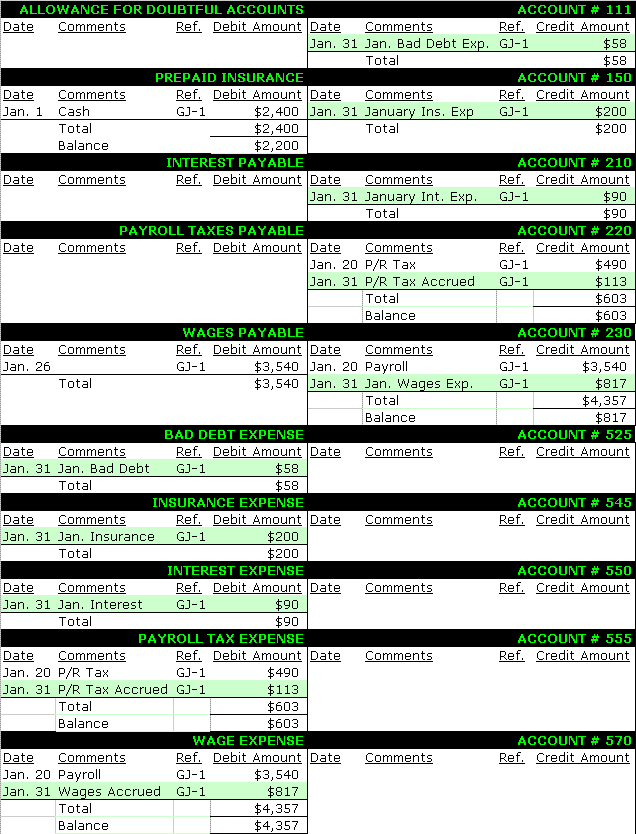Adjusting Entries Illustrated
Adjusting Entries in the Accounting Cycle Continued
| Adjusting entries are made to account for activity that occurred but was not yet recorded during the reporting period. |
Similar to other accounting entries, adjusting entries are entered into the accounting journal and posted to the general ledger accounts.
Continuing with step five in the accounting cycle, Sunny Sunglasses Shop requires the following adjusting entries for January to maintain accurate financial records for the month:
- Prepayments
- An Adjustment to prepaid insurance to record $200 consumed in January.
- Accruals
- An adjustment to record interest expense for the month of January for the mortgage on the land.
- An adjustment to record wages payable to employees for work performed during the last week of the month but not yet paid.
- Estimated Items
- An adjustment to accounts receivable for what the company estimates as uncollectible for the month.
The adjustments are first entered into the accounting journal, and then posted to the general ledger just like steps two and three for the regular accounting entries. This process is illustrated below:
Adjusting Entries and the Accounting Journal
- Sunny originally recorded the purchase of insurance for the year as a prepaid expense, or asset, for $2,400. At the end of January, he now debits insurance expense to increase the expense, and credits the asset prepaid insurance to reduce the asset. The prepaid insurance balance is now $2,200 as shown in the general ledger below.
- The company owes 6% on the $18,000 mortgage for land on a yearly basis. To recognize the monthly portion of the yearly interest expense of $1,080 on the monthly financial statements, Sunny debits the interest expense, and credits interest payable for $90. Sunny is not paying the interest at this time, so crediting interest payable increased the liability account, or amount owed for interest as recognized in January ($1,080/12).
- Sunny owes one week of wages to employees for hours submitted for the last week of January. Because he will not pay the wages of $817 until payday in February, Sunny recognizes the expense for both the wages and the employer payroll tax due of $113 (employer Social Security, Medicare, state unemployment taxes, and federal unemployment). Sunny debits (increases) the wage and payroll tax expense accounts, and credits (increases) the liabilities, or payables, for each. Sunny will debit wages payable and credit cash when the wages are paid in February. When Sunny files and pays his employer taxes, he will debit payroll taxes payable and credit cash.
- Sunny estimated that 1% of total credit sales will not be collected. This equates to approximately $700 for the year. To recognize the January portion of the estimate, Sunny debits (increases) the bad debt expense account for $58 ($700/12), and credits allowance for doubtful accounts. Allowance for doubtful accounts is a subsidiary, or contra account of accounts receivable that reduces the balance by the amount in the contra account. It is also shown on the balance sheet with accounts receivable.
The process for posting entries to the general ledger and referencing each account based on the chart of accounts is the same for regular accounting entries as it is for adjusting entries in the accounting cycle.
The adjusting entries are posted to the general ledger accounts, resulting in new totals for each account affected:
Adjusting Entries and Ledger Accounting
Sunny reduced prepaid insurance by $200 to equal $2,200, and increased insurance expense which now equals $200 for the month.
Sunny already paid wages earlier in the month of $3,540, so the balance outstanding for wages payable now equals the adjustment of $817. He does, however, still owe payroll tax for both payrolls totaling $603. Sunny will pay these taxes quarterly, and debit account #220 to reduce the liability when he makes the payment.
The total expenses incurred for wages and payroll taxes are posted to the expense accounts (#555 payroll tax expense and #570 wage expense) because both expenses were incurred in January, even though part of them entered on Jan. 31 were not yet paid.
The other adjusting entries posted equal the balance of the general ledger accounts since there was no other activity in those respective accounts before the adjustments.
Adjusting Entries Summary
Adjusting entries serve two main purposes in the accounting cycle:
Adjusting entries provide fairer and more accurate financial information for the reporting period. |
The next step in the accounting cycle is to verify the accuracy of each account after the adjusting entries with the adjusted trial balance.
Back to the Accounting Cycle and Double Entry Bookkeeping Main Page



this is superb.taught in simple way. outstanding